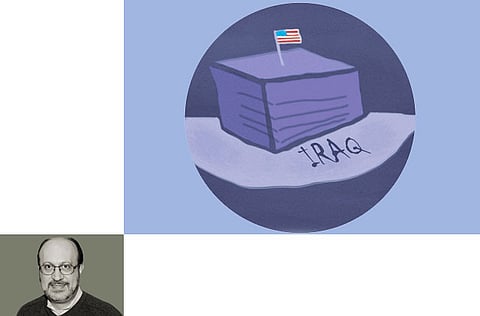Iraq depots to ensure American presence
Facilities built during the war will be handed over to Baghdad, but may be used as bases for future contingencies

Although under the radar, Iraq is not out of its political woes, as daily assaults by armed elements on government facilities continue unabated. As of this writing, the last American combat troops are scheduled to withdraw from the country by the end of 2011, although Washington and Baghdad are in serious talks over whether to keep a limited American presence into 2012 and beyond.
The war for Iraq, which started in 2003, and which will probably hit a crescendo after the putative US withdrawal, may yet entangle those who concluded that several permanent bases were necessary. Will Iraq become a new American military depot akin to Britain that was long considered America's fixed aircraft carrier in Europe?
On the surface, the US will hand over its bases, along with an incredibly array of equipment estimated to be worth billions of dollars. While the Department of Defence routinely donates surplus equipment duly paid for by US taxpayers, the Iraq giveaways will include at least four gigantic military bases not only to save the expense of dismantling them but also to have a foothold in the region for possible future uses. To be sure, retired Army Maj. Gen. Paul Eaton, who oversaw the training of Iraqi soldiers from 2003 to 2004, lamented that the bargain donations effectively meant Washington was losing out, but this was less than genuine.
In fact, the 39 remaining US military bases — out of 505 — included four large facilities which cost over $2 billion to build. The Al Asad Airfield in Anbar province, for example, is so well equipped that most servicemen refer to it as "Camp Cupcake." Likewise, at the Joint Base Balad, huge dining halls cater to thousands, many of whom have access to a "25-metre swimming pool, a high dive, a football field, a softball field, two full-service gyms, a squash court, a movie theatre, and the US military's largest airfield in Iraq." One can only imagine the numerous items stocked at each — from toothbrushes to bombs — though the Department of Defence estimated that at least 2.4 million pieces of equipment worth a total of at least $250 million (Dh919.5 million) were donated to the Iraqi army over the course of the past 12 months alone.
Assumption
For reasons that remain murky, why did Washington authorise and actually build colossal facilities in Iraq if the assumption was not to transform the country into a long-term staging area for US troops in the Gulf region? Why create an extensive infrastructure to support large numbers of troops that would be fully operational with their latest equipment, if the American presence was temporary? Was it all a waste of money? Were there no dissenting voices that warned the Bush and Obama administrations that militarization was not a long-term option?
Typically, few evaluated these questions, especially after media pundits moved on to fresher stories. An overall fatigue factor settled on Iraqi news, although George W. Bush and Nouri Al Maliki signed a comprehensive security agreement in November 2008 that hinted at what may be coming next. To be sure, American combat troops are set to leave Iraq, but not one of the major bases was evacuated so far. Even more problematic, many wondered whether Baghdad would know how to preserve and use these facilities, especially since the track record was relatively poor.
Sadly, undisciplined soldiers looted several bases that were transferred within hours of US departures, which highlighted intrinsic problems nearly a decade after the self-appointed Pro-Consul L. Paul Bremer abolished the Iraqi army on May 23, 2003. As Baghdad rebuilds its military institutions, and puts an end to the systematic looting that occurs almost daily, key decisions will need to be made regarding who needs the air-conditioning units, power generators, beds and other essentials taken from various barracks: the soldiers or their families?
Incredibly, there is so much excess personal property scattered throughout Iraq — things that few categorise as military hardware, like water tanks, refrigerators, beds, mattresses, office equipment, dining facilities and so on, all of which cost a great of money — that the Government of Iraq will need to decide who "acquires" them. Baghdad might not know what to do with all of this excess equipment, but military officials will soon inherit a windfall, and it might be useful to have a plan in place.
Iraqi officials, who are anxious to rebuild critical institutions like the military, ought to assess how useful these excess items will be, now that Prime Minister Nouri Al Maliki signed a first contract for 18 F-16s. Yet because 18 were barely enough to fill a single squadron, it will not be long before a second contract for another 18 F-16s is signed. With additional military assets acquired from Britain and France — all to empower the country as it reconstitutes a credible defensive punch. Naturally, since windfall oil revenues are available to purchase big-ticket items, few should be surprised when Baghdad goes on a buying spree, ostensibly to close its defence gap after US forces withdraw. Today, Iraqi commanders are planning for 96 F-16s, enough for five squadrons deployed around the country, especially at Al Asad and Al Balad, where joint air missions with visiting American forces will ensure that the latter's investments were not wasted. As well as keep the facilities functioning — just in case.
Dr Joseph A. Kechichian is a commentator and author of several books on Gulf affairs.
Sign up for the Daily Briefing
Get the latest news and updates straight to your inbox


